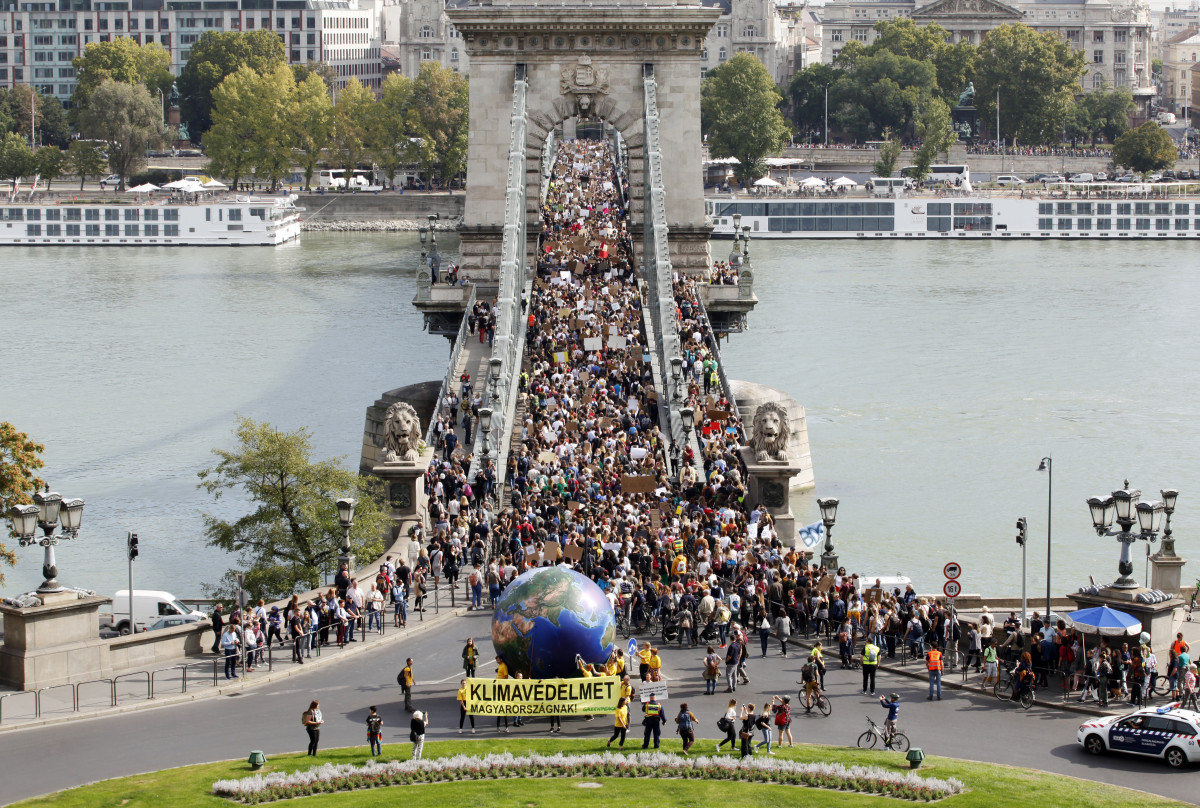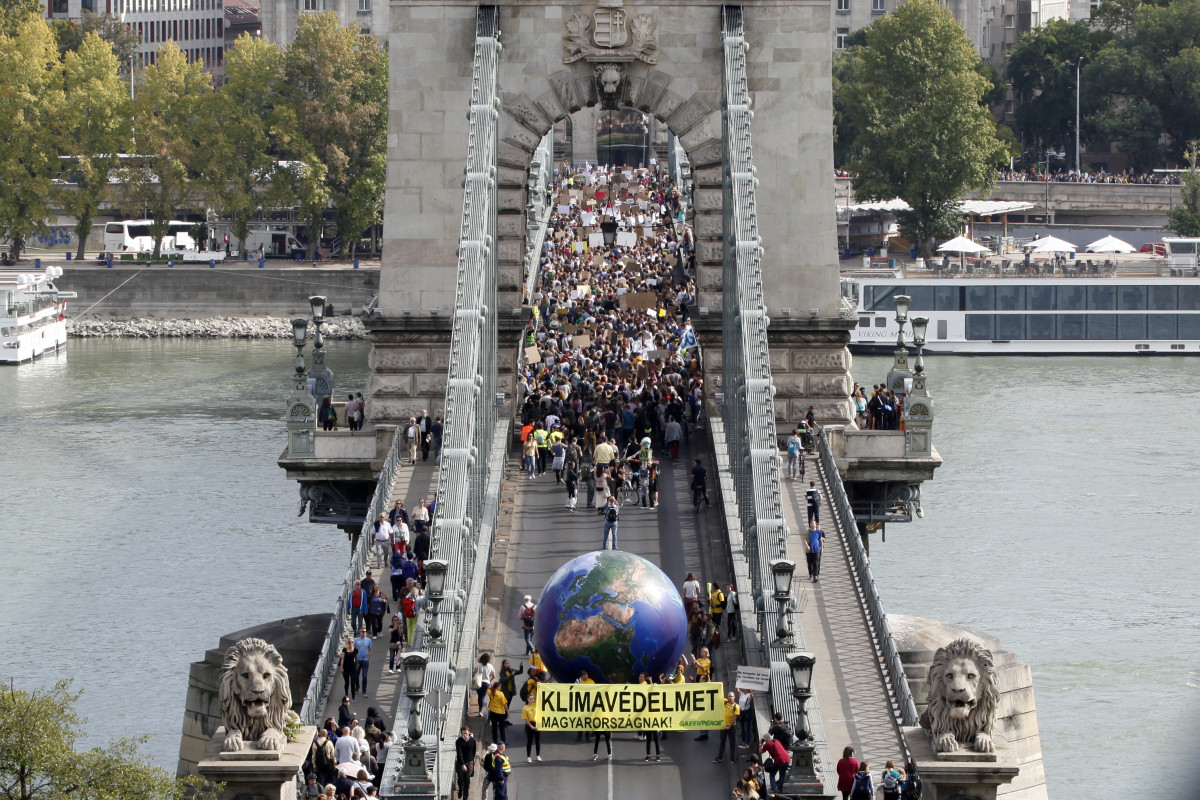Hungary’s climate activists struggle to make their voices heard
Hungary’s populist right-wing government, social conservatism and a biased media landscape are making it increasingly difficult for the country’s climate activists to get their message across. Yet, thus far the movement has refrained from following the example of their Western European counterparts with more radical actions, such as motorway and airport blockades.
Even the Hungarian branch of Extinction Rebellion (XR), a movement known for spectacular direct action in other countries, such as the United Kingdom, does not believe that acts of civil disobedience considered as too radical would favour their cause.
“The social and legal environment is less conducive to spectacular actions, such as the summer bridge blockades in London,” said Dániel Pap, a Hungarian XR activist. “Hungarian society seems a little less open in this respect, so we think that if we were to try something similar here at home, it would be very negatively received.”
Fridays for Future activist Kinga Somlói also said she would not participate in highly controversial acts of civil disobedience. “While I think there is a need for a radical change of attitude and consequent action, radical awareness-raising is not always the right thing to do,” said Somlói, who described Western Europe’s radical climate protests as an “ultimate expression of desperation.”
Multiple crises sap public attention
Hungarian society is deeply polarised, and the country’s political system is unlike any other EU member state. For the past 12 years, the populist right-wing Fidesz party has dominated politics, and entrenched its power. The EU has long accused prime minister Viktor Orbán of undermining democracy, and the European Parliament has brandished the country’s as an “electoral autocracy.”
But Hungary’s increasingly authoritarian government isn’t the only factor impeding effective climate protests. Just like in many other countries, the coronavirus pandemic, the subsequent energy crisis and Russia’s military aggression against Ukraine have diverted the public’s attention away from climate protection in Hungary, resulting in lower protest attendance.
“To put it simply, there have been far fewer people present or interested in our protests recently and this has become immensely noticeable,” Simon Péterfy, a high school student and Fridays for Future activist, commented.
While this year’s historic drought offered a first-hand experience of global warming to Hungarians, other issues seem more pressing to most citizens. Public discourse is currently dominated by the government’s opposition to EU policies, the deepening cost-of-living crisis in a country with the EU’s worst inflation rate above 20 percent, and government accusations of foreign election meddling in support of the opposition.
Climate activists join escalating teachers’ protest
An escalating protest by teachers against low wages and an overstuffed curriculum, which is supported by many students and parents, is also receiving a lot of attention, and is closely watched by climate activists. “Demonstrations with a more tangible cause and rather specific demands catch the attention, such as the teachers’ protest,” Extinction Rebellion activist Pap said. Many civil society organisations, including environmentalists like Greenpeace, Fridays for Future and Extinction Rebellion, have joined these recent demonstrations. They argue that advancing human rights, prosperity and welfare is a prerequisite for effective climate action.
“You need to create the right living conditions to allow people to make informed decisions – otherwise you can’t expect them to buy a product wrapped in paper that is 300 forints [0.70 euros] more expensive than the one wrapped in plastic,” Fridays for Future activist Péterfy said.
Many climate activists hope that they are indirectly advancing their own cause by helping teachers reach their goals of higher wages and better working conditions. “The current Hungarian school system is not capable of providing a modern, 21st century education. It does not help children to understand contemporary problems, and teach them to look for solutions,” András Perger from Greenpeace Hungary commented. “Without a strong ecological framework in education, how could we expect to address global environmental and climate problems?”
Joining the teachers’ protests has exposed climate activists to criticism from pro-government opinion leaders, who accuse them of being opportunistic and aligned with the opposition.
“Since recently, teachers’ protests have been the ones that mobilised opposition voters. These climate activists understandably want to build on them to become more visible,” political analyst Dániel Deák from the XXI. Century Institute. said. He is also a right-wing political influencer at Megaphone centre, both of which are considered pro-government.
Activists lament that current climate demonstrations do not seem to have any impact, and instead mainly provoke negative reactions. Fridays for Future activist Somlói recalled many complaints when the group advertised this year’s global climate strike on Facebook, with some comments instructing them to do something “more useful,” like picking up trash. She said she feels this attitude is more pronounced in Central Eastern Europe, especially in Hungary, for historical reasons. “I believe Hungarians have been socialised for a long time to be self-absorbed and only think of themselves, therefore many people lack empathy and solidarity towards others outside of their immediate circles,” said the young activist, who is studying sociology at Hungary’s Eötvös Loránd University.
Attention faded after Fridays for Future success
However, earlier climate protests proved that this kind of activism can succeed in Hungary as well. Greta Thunberg’s school strike, which started in September 2018 and rapidly developed into the worldwide Fridays for Future movement, managed to push climate activism to the forefront in Hungary as well.
"When Greta Thunberg and the climate movement, including Fridays for Future and Extinction Rebellion, burst onto the scene, there was a palpable shift in the public opinion, with the media naturally making a strong contribution,” Extinction Rebellion’s Pap said. “There was unprecedented coverage of climate change and the activists working to stop it. This had a huge impact here in Hungary as well, with crowds of around ten thousand people participating in the country’s biggest climate protest ever.”
The widely attended global climate protest of September 2019 was a high point of Hungary’s climate movement, and managed to defy government ridicule. The day before the march, Gergely Gulyás, who heads the prime minister's office, publicly mocked the demonstrations. He said it is “a testament to the sanity of Hungarian society that no one but a few dozen activists care" about it. The next day, however, thousands of mostly young people marched through the streets of Budapest, and protests were held in other parts of the country, offering a strong rebuke to Gulyás’s words. For many participants, this event was a formative experience: They realised that even in Hungary, a significant part of the youth is concerned about climate change.
“This global strike was the day I decided to join Fridays for Future as a volunteer. I saw that I can't achieve anything truly significant alone, but within a community actively fighting for the environment, I feel my efforts are paying off a little bit,” Somlói said.
However, the Hungarian climate movement’s ascent was abruptly cut short. “From 2018 until the first quarter of 2020, there was a fortunate period when climate protection was identified as one of the most critical problems facing Hungary,” recalled Greenpeace’s Perger. “Public pressure pushed the issue high on the political agenda. Prime minister Viktor Orbán even unveiled the climate and environmental action plan in his yearly, informal state of the nation speech held on 2020 February. Then Covid came.”
Media bias against climate activists
Many climate activists blame government control of the media for the waning interest in climate issues. Almost 80 percent of political and public affairs news is financed by sources directed by the ruling party, according to a 2019 study by think tank Mérték Média Monitor. The recent UN climate conference (COP27) in Sharm El-Sheikh did not receive any coverage at all in the one-hour prime-time newscasts of the public media.
“The pro-government media hardly reports on the climate protests and initiatives, and even then they tend to portray them negatively,” Pap said. “So, you can say that the pool of people we can reach and convince to get involved in our cause is smaller than it could be."
There are, indeed, signs of bias in the pro-government media against the climate movement. E-mails leaked to Politico showed, for example, that a senior editor of the public media (MTVA) had told news agency staff in November 2019 they need permission to report on Thunberg. In practice, this meant that the Swedish activist’s name was featured in a total of eight reports after the order was issued.
But pro-government observers deny that the mainstream media overlook climate change.
“A weekly half-hour magazine on public media, Planet 22, is devoted exclusively to this topic, which is rebroadcast several times a week,” analyst Deák said. “Other similar outlets also cover climate protection regularly.”
Deák insisted that climate protection is not a partisan issue in Hungary. “The position of the right-wing government has always been clear: safeguarding the environment, God’s creation, is a fundamental conservative value. So, this is not an ideological issue, it is a practical one.” Deák also pointed to last year’s Planet Budapest exhibition, which was branded as the largest sustainability summit in the region, as proof of the government’s climate action. “You cannot say that the government is not doing anything about climate change, as Hungary has fulfilled all its emissions commitments so far, and it is doing even more than that.”
Hungary’s government has set the target to make the country climate neutral by 2050 and insists it is making steady progress towards achieving this goal. It points to a report by German auditing and consultancy firm KPMG from last year, which ranked the country 13th in its “Net Zero Readiness Index.”
Bleak picture
But the latest Climate Change Performance Index (CCPI) by German environmental and development organisation Germanwatch paints a much less rosy picture of the Hungarian government’s achievements. It ranks Hungary among the ten lowest-performing countries on its 59-nation list, the second worst among EU member states behind Poland. According to the report, experts see “no practical signs that the Hungarian government is committed to reducing [greenhouse gas] emissions in line with the EU targets.” In contrast, “it has taken several steps to the contrary, including an increase of certain fossil fuel subsidies,” and blocking EU climate policies, the report said.
In response to the energy crisis triggered by Russia’s war in Ukraine, Hungary has stepped up purchases of Russian gas, whereas many Western European countries vowed to boost the rollout of renewables in the name of climate action and energy independence. Building new wind turbines has been effectively banned in Hungary since 2016, and newly installed solar panels in households can’t be connected to the electric grid. The fact that the government doesn’t have a ministry for the environment, let alone for the climate, is seen as a further sign that emission reduction is not among its priorities.
The enormous difficulties they face in Hungary has only served to strengthen some climate activists’ resolve. Asked whether she was envious of her Western European counterparts, who operate in a more welcoming environment, Fridays for Future’s Somlói replied: “Maybe they should be jealous of us, because we had a worse starting position. If we manage to overcome the obstacles and achieve our goals, then ours will be an even greater accomplishment than theirs could ever be.”




